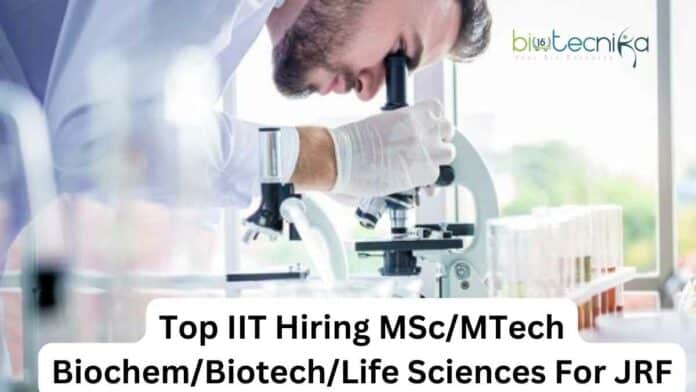JRF Post for Life Science/Biochem/Biotech- IIT Hyderabad!
This job expires in
Advertisement for the post of a JRF in Structural Biology
Applications are invited from candidates with excellent academic records and relevant research experience for the DBT-sponsored project at the Department of Biotechnology, IIT Hyderabad.
Job Title: JRF in Structural Biology
Title of the research project: Mechanistic understanding of the functioning of Chd1 remodelers using biochemical, structural, and single-molecule imaging approaches.
Description of the job: Experiments for protein expression and purification from E. coli, in-vitro biochemical reconstitution, in-vitro and in-vivo assays for protein interaction
dynamics, single-molecule imaging, yeast genetics, data analysis, manuscript
writing.
Duration of JRF Post for Life Science/Biochem/Biotech- IIT Hyderabad : 2 years
Age Limit: 35 years
How to apply?:
Eligible candidates should fill out a Google form by 25th September 2023. Shortlisted
candidates will be contacted by email to send a CV and cover letter.
Selection procedure:
Candidates will be shortlisted for the interview based on their academic records and relevant work experience. Only short-listed candidates will be intimated via email for the online interview. Please note that merely meeting the eligibility criteria does not guarantee a call for an interview. The committee reserves the right
to leave the position vacant if no suitable candidate is found.Remuneration: Rs. 31,000 + 24% HRA per month
Eligibility:
- M. Sc./M. Tech./M.E. in Biochemistry/Biotechnology/Life Sciences with at least 80% (CGPA 8).
- GATE or CSIR-UGC-NET (LS) qualification.
- Prior research experience in protein biochemistry, structural biology, invitro macromolecule assembly, or yeast genetics will be preferred.
Click here for the notification
JRF Post for Life Science/Biochem/Biotech- IIT Hyderabad. The possible interview Q & A to help you with:
Q: Can you describe your experience with protein expression and purification from E. coli?
A: During my academic and research endeavors, I have gained extensive experience in protein expression and purification from E. coli. I have successfully expressed and purified various target proteins, ensuring their high purity and bioactivity. This expertise will be invaluable in our research on Chd1 remodelers.
Q: How would you approach conducting in-vitro and in-vivo assays for protein interaction dynamics in the context of this research project?
A: To investigate protein interaction dynamics, I would first design and perform in-vitro assays using techniques such as co-immunoprecipitation and surface plasmon resonance. For in-vivo assays, I would utilize yeast genetics to introduce mutations and study their effects on protein interactions. This integrated approach will provide comprehensive insights into the functioning of Chd1 remodelers.
Q: Can you explain your experience with single-molecule imaging techniques?
A: I have hands-on experience with single-molecule imaging techniques such as fluorescence microscopy and atomic force microscopy. These methods allow for the visualization of individual molecules and their interactions, providing crucial data for our research on Chd1 remodelers.
Q: How do you handle data analysis in your research work, especially in the context of this project?
A: Data analysis is a critical component of any research project. I am proficient in using software tools like MATLAB, Python, and specialized bioinformatics packages for data analysis. For this project, I would employ these skills to process and interpret experimental data, ensuring the robustness of our findings.
Q: Can you discuss your experience with scientific manuscript writing and publication?
A: I have authored and co-authored several research papers that have been published in peer-reviewed journals. I am well-versed in the process of manuscript writing, from drafting to final submission. Effective communication of research findings is essential, and I am committed to contributing to the dissemination of our project’s results through high-quality publications.































